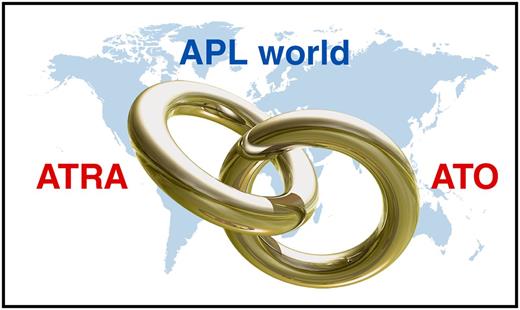In this issue of Blood, Abaza et al1 summarize the excellent long-term outcome of 187 patients with acute promyelocytic leukemia (APL) undergoing a (mostly) chemotherapy-free first-line treatment. This report is a follow-up and extension of 2 initial reports by the MD Anderson group,2,3 who were among the first to explore all-trans-retinoic acid (ATRA)/arsenic trioxide (ATO)–based therapy as a first-line regimen for APL patients. In the 2006 report, ATO was started 10 days later than ATRA due to concerns about potential cumulative toxicity, but was later modified to a concomitant administration from day 1 onward. The most important prognostic factor in APL is the white blood cell count at diagnosis, which allows distinguishing patients with higher-risk or lower-risk disease (> or ≤10 G/L). In both APL risk groups, an ATRA plus anthracycline-based (idarubicin or daunorubicin) induction strategy is followed by 3 cycles of chemotherapy-based consolidation therapy. In the past decade, this risk-adapted therapeutic approach has led to nearly equivalent outcomes with regard to relapse rates in both patient risk groups. Still, relapses occur in up to 20% of patients receiving standard ATRA plus chemotherapy-based therapy.
ATRA and ATO in APL: from occasional date to civil union. Professional illustration by Patrick Lane, ScEYEnce Studios.
ATRA and ATO in APL: from occasional date to civil union. Professional illustration by Patrick Lane, ScEYEnce Studios.
In the current study, all patients with higher-risk disease, but also those with lower-risk APL developing leukocytosis (45%), received either gemtuzumab ozogamicin (GO) or idarubicin in addition to ATRA/ATO. This strategy is likely to represent an overtreatment in the setting of lower-risk patients because leukocytosis can be adequately managed by hydoxyurea only.4,5 Only 7 patients (4%) relapsed (5 of whom were higher risk). Relapses occurred mostly within the first year after treatment, were captured at the minimal residual disease (MRD) level, and could be successfully salvaged in the majority of cases. This observation highlights the fact that although disease recurrence remains a very rare event with this regimen,4 patients should be followed by MRD surveillance for a period of at least 2 years.
Importantly, the data generated in this study have provided the basis for several subsequent randomized trials,4-6 which have demonstrated the superiority of an ATRA/ATO–based regimen compared with the ATRA-chemotherapy approach. Together these studies paved the way for the recent European Medicines Agency approval of ATO (in combination with ATRA) as first-line therapy of lower-risk APL.7 What a great success story in hematology! ATRA and ATO have now progressed beyond an occasional date to a true civil union (see figure) for lower-risk APL patients.
Which challenges now remain in APL management? First, early death still occurs in up to 20% of APL patients. Rapid diagnostics and supportive care together with immediate access to ATRA-based therapy, preferably in specialized centers, are the goals of current efforts in the APL field. Even with the approval of ATRA/ATO in lower-risk APL disease, we continuously need “real-life” data from large registries of APL patients treated with this chemotherapy-free approach. Second, higher-risk APL patients should still receive ATRA plus chemotherapy outside of clinical trials. Interestingly, some of the higher-risk patients in the study by Abaza et al received a single dose of idarubicin instead of GO as part of their induction therapy, translating into a similar 5-year survival rate. In fact, the European randomized intergroup study “APOLLO” (NCT02688140) is currently investigating 2 doses of idarubicin only in addition to the ATRA/ATO regimen in comparison with the standard ATRA-chemotherapy approach. It is hoped this concept will become a success story for our patients as well.
Conflict-of-interest disclosure: U.P. has received honoraria from Teva for participation in advisory boards or lectures at conferences.

